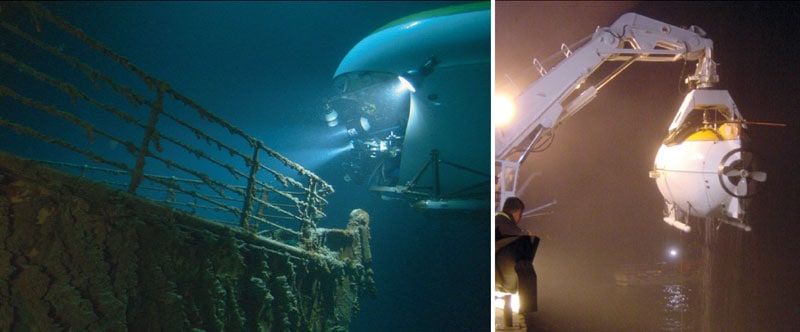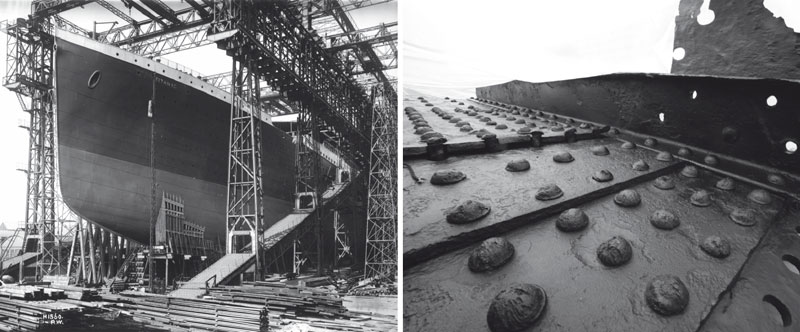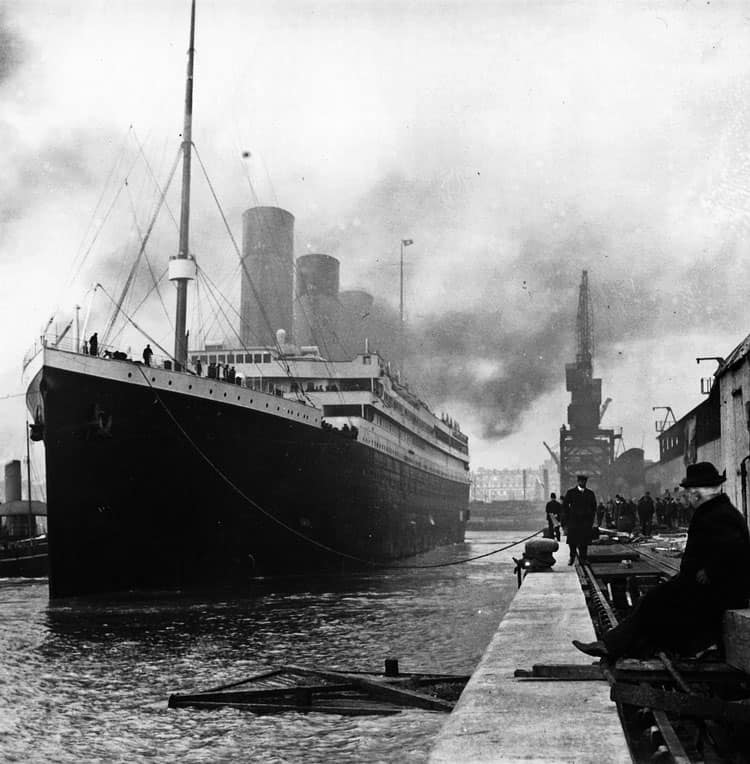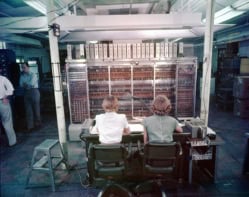A century on from the Titanic tragedy, Richard Corfield says that the cascade of fateful events that led to her demise was partly caused by the science of the ship’s construction

One hundred years ago this month, the world reverberated to the news that the largest ship in the world had met with destruction on her first ever outing.
At 11.40 p.m. on Sunday 14 April 1912, the Royal Mail Steamer Titanic, bound from Southampton to New York, collided with an iceberg and sank within three hours, with the loss of more than two-thirds of the 2224 passengers and crew.
The world was stunned, for the superlatives that had followed the launch of the Titanic from the Harland and Wolff shipyard in Belfast had been stupendous – some would say almost say hubris-inducing. Nature stepped up to the challenge and with almost contemptuous ease sent the Titanic to an icy grave 4 km deep at 41° 43′ N, 49° 56′ W off the Grand Banks of Newfoundland. The Titanic‘s last reported position was 41° 46′ N, 50° 14’ W, although this was later shown to be out by more than 20 km, an inaccuracy that greatly contributed to the difficulties encountered while trying to locate the wreck.
When people ask the question “What sank the Titanic?”, at first glance the answer is obvious: she hit an iceberg. But that simplistic answer masks deeper and more substantive questions: why did the Titanic hit the berg in the first place and why did she sink so quickly?
It is a mistake to regard the Titanic as somehow primitive. She was the most modern ship of her day in a world that relied on its steam trade to maintain communications between Europe and America in the same way that today we rely on aviation. The Titanic incorporated the latest technological innovations of the age to help ensure her safety. For example, she was one of the first ships to have sealable watertight bulkheads – transverse partitions that cross the ship at right angles to its long axis – with electrically operated doors that could be closed from the bridge at a moment’s notice. The hull, as was standard for the day, was made of mild steel (steel with a maximum content of 0.35% carbon, 0.7% manganese and 0.5% silicon) and was held together by three million steel and wrought-iron rivets. Although steel rivets are stronger than wrought iron, for technical reasons (as we shall see) they could only be used in the middle three-fifths of the ship’s length. She also carried the latest Marconi wireless equipment – the most powerful in use at the time with a 5000 W transmitter that gave a radio range of more than 500 km.
On the face of it, the human factors were stacked in the Titanic‘s favour too. For her maiden voyage she had the most experienced crew of the entire White Star Line (one of the premier British shipping lines of the day) on board and it in turn was commanded by Capt. Edward J Smith, the commodore of the line.
It is also worth noting that the North Atlantic shipping run was very far from being an unknown quantity in the Edwardian era. It was as busy as the air route between Europe and America is today, and the chances of seeing a fellow ship en route were as high as an air traveller seeing a fellow aircraft today.
But the simple truth is that against all odds and expectations, including those of the ship’s designers, Lord Pirrie of the Harland and Wolff shipyard and Thomas Andrews of the White Star Line itself, the Titanic sank as completely as a stone, less than three hours after she had hit the iceberg. If she had stayed afloat longer, then rescue ships could have got to her and the tragic loss of life mitigated or averted. This is the real question of the Titanic mystery: how could a 46,000 tonne ship sink so quickly? The answer is to be found within the science of the Titanic‘s construction and the events that occurred on that fateful voyage.
Details emerge
After the sinking of the iconic ship there was no shortage of theories as to why the pride of the White Star Line had foundered. Two inquiries in 1912 led by Senator William Alden Smith in the US and Lord Mersey in the UK both reached remarkably similar conclusions. The Titanic had been travelling too fast, Smith had paid too little heed to iceberg warnings and, of course, there had not been enough lifeboats on board to carry every passenger to safety. Although this last fact is inescapable, it is less well known that the Titanic carried more lifeboats than she was required by law to do. It seems that in 1912, in a way not dissimilar to our own box-ticking, responsibility-avoiding culture today, lack of effective oversight on the part of the authorities caused the consequences of the disaster to be much worse than they might have been.
As the inquiries unfolded, other details began to emerge. There had been a reshuffle of officers just before the ship had sailed and the second officer, David Blair, had left the ship – bumped from the roster by the more senior Charles Lightoller. Blair had taken with him the key to the locker that held the binoculars used by the lookouts in the crow’s nest. Also, the more senior of the two radio operators – Jack Philips – had not passed on the fifth and most specific ice warning of the day received from the SS Mesaba. Mesaba gave the precise location (42° to 41°, 25′ N; 49° to 50°, 30′ W) of an area of icebergs that, at the time, approximately 9.40 p.m., was only 50 miles dead ahead of the Titanic. Because the message – “Saw great number large icebergs also field ice. Weather clear.” – was not prefixed with “MSG” “Masters’ Service Gram”), which would have required a personal acknowledgement from the captain, Philips interpreted it as non-urgent and returned to sending passenger messages to the receiver on shore at Cape Race, Newfoundland, before it went out of range.
The physical facts
There is one aspect of the Titanic disaster that was known from the time the ship hit the iceberg: if more than four of the 16 watertight compartments into which the interior space of the Titanic was divided were flooded, the ship could not stay afloat. The Titanic‘s designer Thomas Andrews was on board and was asked by Capt. Smith to accompany him to assess the damage immediately after the collision. The impact had been on the for’ard starboard side below the water line and once Andrews had discovered the extent of the damage he warned Smith that since more than four compartments had been ruptured (six in fact had been breached) “it was a math- ematical certainty that the ship would sink”.
This, of course, the Titanic duly did.
Yet the detailed science behind the sinking of the Titanic had to wait 90 years to be explored. Her wreck was discovered by the submersible Alvin during a joint French–American expedition in 1985 of which the archaeological oceanographer Robert Ballard was a prominent member. Ballard returned the next year to start analytical work on the wreck and since then there have been many expeditions to the site – mostly, it has to be said, for the purposes of sightseeing, with a handful of scientific expeditions thrown in.
Curiously enough, Ballard had not been driven to develop his new technology (the Argo-Jason system) specifically to find the Titanic‘s ancient wreck. As he told the US Academy of Achievement in an interview in 1991, he simply wanted to test his system in the deepest water he could easily get to. “If the Titanic had been in the Indian Ocean, I probably would have never found her,” Ballard said. “But the fact that she was in my backyard, I went, ‘Let’s go find the Titanic.’ ”
An early attempt to explain the cause of the Titanic‘s rapid sinking was related to physical tests on the steel comprising the ship’s plates. Early tests made by metallurgists in Canada suggested that the steel of her hull plates became brittle at about 32 °C, suggesting that it would have been prone to fracture at the temperatures the ship would have been operating at. This contrasts with modern steels where the ductile–brittle transition temperature is –27 °C. However, more sensitive tests that have since been carried out, which conform more closely to the characteristics of the Titanic‘s impact with the iceberg, suggest that the steel of the ship’s plating was adequate to bend with the impact rather than fracture.
In the mid-2000s two metallurgists, Tim Foecke at the US National Institute of Standards and Technology and Jennifer Hooper McCarty, then at Johns Hopkins University in the US, focused their attention on the composition of the Titanic‘s rivets. They combined their metallurgical analysis with a methodical sweep through the records of the Harland and Wolff shipyard in Belfast where the Titanic was built. Combining physical and historical analysis in this way proved to be a powerful trick.
Foecke and McCarty found that the rivets that held the mild-steel plates of the Titanic‘s hull together were not of uniform composition or quality and had not been inserted in a uniform fashion. Specifically, Foecke and McCarty found that the rivets at the front and rear fifths of the Titanic were made only of “best” quality iron, not “best-best”, and had been inserted by hand. The reason for this was that, at the time of the Titanic‘s construction, the hydraulic presses used to insert the rivets used in the middle three-fifths of the ship could not be operated where the curvature of the hull was too acute (i.e. at bow and stern).
But why did Harland and Wolff use “best” quality rivets rather than “best-best?” Foecke and McCarty speculate that it may simply have been a cost-saving exercise. “Best” rivets were cheaper than “best-best” but also had a higher concentration of impurities known as “slag”. This higher concentration of slag meant that the rivets were particularly vulnerable to shearing stresses – precisely the kind of impact they were subjected to that long-ago night in April 1912. Lab tests have shown that the heads of such rivets can pop off under extreme pressure, which on the Titanic would have allowed the steel plates on the hull to come apart, exposing her inner chambers to an onslaught of water.
Riveting stuff
James Cameron, director of the film Titanic (which is this month re-released in 3D), seems clear that it was the rivets that were at fault. If you look at the relevant section of his film, at about 100 minutes in, you will see the bulkheads being split asunder along the line of rivets, which pop like champagne corks into the interior of the vessel. This sequence is worth watching and rewatching because it is spot-on in terms of accuracy. Cameron, incidentally, began a degree in physics at Fullerton College in the US and is well known for his unstinting obsession with accuracy – an accuracy that is apparent in the detail of his Titanic.
For example, in the film, just prior to the iceberg impact you will notice that First Officer Murdoch telegraphs to the engine room for the engines to be put into reverse. Of the Titanic‘s three engines, the central engine (a Parson’s turbine with a screw mounted directly behind the rudder) could not be reversed and so only slowed to a standstill. The two reciprocating engines driving the port and starboard screws on either side of it could, however, be reversed, and Cameron faithfully records the central propeller as being stationary as the ship starts the dramatic evasive manoeuvre, even as he shows the outboard propellers beginning to reverse.
The configuration of the propellers and rudder that Cameron so faithfully renders also bears on the reasons for the ship’s sinking. On the one hand, it took time for the propellers to be stopped and then put into full reverse, plus, as we have seen, the steering propeller was stationary. On the other hand, because the rudder, which steers the ship, was most effective when controlling the laminar flow of water created by the steering propeller, the fact that the steering propellor was not rotating severely diminished the turning ability of the ship. It is one of the many bitter ironies of the Titanic tragedy that the ship might well have avoided the iceberg if Murdoch had not told the engine room to reduce and then reverse thrust.
Effects from afar
Finally, there is a new twist to the science of why the Titanic foundered. North Atlantic icebergs are calved on the western coast of Greenland, then circulate anticlockwise through the Labrador Sea before drifting into the North Atlantic off the Newfoundland coast. There they meet the Gulf Stream heading north-east on its long journey to bathe the shores of north-western Europe. There are significant temperature and density differences between these two currents and when they are most pronounced – for example when the Gulf Stream is warmer than usual – the icebergs tend to be corralled into an approximately straight line along the axis of the boundary interface. In other words, they make a barrier of ice.
Richard Norris of the Scripps Institution of Oceanography in San Diego, California, is leading an expedition of the Integrated Ocean Drilling Program to the area this summer. “The Titanic hit the iceberg right at the intersection of the Labrador Current and the Gulf Stream,” he says. “1912 had an unusually hot summer in the Caribbean and so the Gulf Stream was particularly intense that year. Oceanographically, the upshot of that was that icebergs, sea ice and growlers were concentrated in the very position where the collision happened.”
New research raises the possibility that celestial influences conspired to doom the Titanic from even further afield. Astronomers Donald Olson and Russell Doescher from Texas State University–San Marcos this month published their findings about an extraordinary event on 4 January 1912, three months before the disaster. On that day the Sun was aligned with the Moon in a way that enhanced its gravitational pull, causing a higher-than-usual “spring tide”. This is nothing exceptional in itself. More remarkable was that on the same day in 1912 the Moon made its closest approach to the Earth in more than 1400 years – in other words, its tide-raising forces were at a maximum. On top of that, the Earth had reached its closest position to the Sun – the “perihelion” – the day before.
At first glance it is hard to see how an unusually high tide might have affected the Titanic more than three months later. The North Atlantic shipping lanes were peppered with icebergs in April, but if the high tide had caused new icebergs to calve in Greenland in January, they would have had to travel unusually fast to get there by then. But the bergs may have come from a source nearer by. When icebergs pass through the Labrador Sea, they often become stuck in shallow waters and it can take several years for them to be dislodged and continue their journey southward. Writing in the April issue of Sky & Telescope magazine, Olson and Doescher suggest that the high tide in January 1912 could have given many trapped icebergs the buoyancy they needed to lift up away from the ground and continue their journey to the Titanic‘s future graveyard.
It seems therefore that the climate thousands of miles from where the Titanic sank, as well as the positions of the Sun and Moon astronomical distances away, may have been yet further links in the chain that led to the loss of the greatest ship in the world.
Event cascade
So what conclusions can we draw from the events of 14 April 1912, a century after the Titanic sank? First, there can be no doubt that at the very start of the ship’s construction there was a problem with the materials. The steel plates of the time may have been inadequate for the task in waters of those temperatures, and the rivets were of inferior quality. Second, mistakes were made by the crew once the vessel was under way: the absence of binoculars in the crow’s nest; Smith’s decision to maintain a high speed despite the abundance of iceberg warnings; the radio operators’ tardiness in getting crucial information to the officers and their emphasis on passenger messages rather than operational ones; and, of course, the almost cynical lack of lifeboats.
Then there are the maths and physics of the collision: six compartments flooded when, if it had only been four, the ship would not have sunk. And finally, there was the complex interplay of two surface-water currents, as well as the extraordinarily high spring tide three months earlier, that concentrated icebergs as if they were tank traps.
No one thing sent the Titanic to the bottom of the North Atlantic. Rather, the ship was ensnared by a perfect storm of circumstances that conspired her to doom. Such a chain is familiar to those who study disasters – it is called an “event cascade”. The best planning in the world cannot eliminate every factor that might negatively impact on the design and operation of a complicated machine such as a massive passenger ship. Eventually, and occasionally, enough of these individual factors combine and the “event cascade” becomes long enough and complicated enough that tragedy cannot be averted.
Poor Titanic.
Costa Concordia
It may have been 100 years since the Titanic went down, but recent events have shown that the sea remains as hazardous as ever if not treated with respect. On 13 January the Italian cruise liner Costa Concordia struck a rock just off the shore of Giglio Island on the west coast of Italy, tearing a 49 m gash in her hull. The ship, flooding and listing, grounded on the island, where it still lies on its side in shallow water, pending salvage. All but 32 of the total 4252 passengers and crew were saved.
It is too early to speculate on the causes of the crash but there have been reports that the alarm on the navigation computer – which is linked to GPS and has an accuracy of a few metres – may not have been functioning as it should.
If that is the case then the safety features of the Costa Concordia were reduced towards Titanic levels at a stroke. Yet the Costa Concordia still had radar and modern-day echo-sounding equipment, both technologies that were not available to the Titanic.
How these latter were overlooked is, of course, a matter for the board of inquiry, but there may be a cause for concern that modern-day computerized navigation systems have blunted the caution that should run in the veins of all those who “go down to the sea in ships”.







